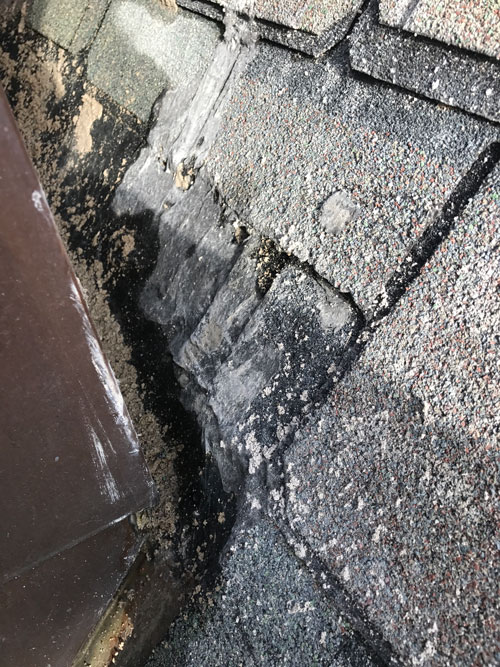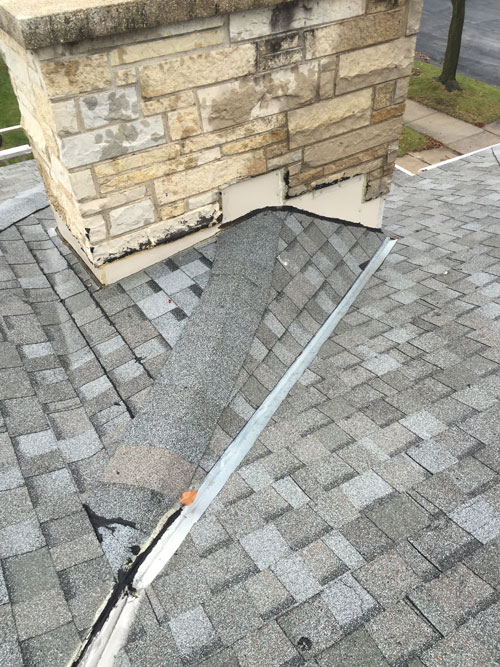Chimney Flashing
Where is the flashing located?
Chimney flashing is located where your roof and chimney meet. Chimney flashings are one of the most common places a chimney will leak. If you’ve noticed leaking in your attic or around your chimney, the flashing likely needs repair.
What is Chimney Flashing?
The flashing needs to be watertight to prevent water or moisture from causing damage to the interior of the house. Flashing involves a series of steps. These steps need to be done in the correct order to prevent any damage and costly repairs. Carlson’s Chimney uses galvanized steel flashing and not aluminum. Aluminum corrodes over time when it comes in contact with the lime in the masonry.
The flashing repair process has three major parts: the underlayment, step flashing (tin singles), and the counter flashing. When replacing the flashing, we install an ice and water barrier underlayment to the wood deck. The ice and water barrier seals the nails as we install the shingles around the chimney. We install tin shingles in sequence with the asphalt shingles so that water doesn’t enter where the shingles meet the brick/stone. The counter flashing is a piece of metal with a ½” bend at the top that is cut into the masonry above the tin shingles. This flashing also stops the water from entering at the top of the chimney. The pieces are then screwed or riveted together. The metal overlaps, so only a single bead of caulk seals the seams.
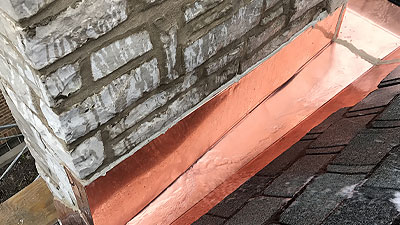
Copper Flashing
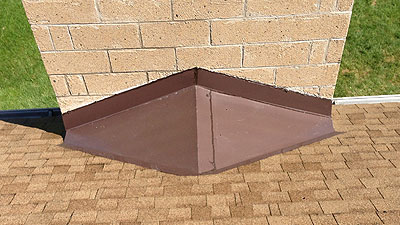
Cricket Flashing
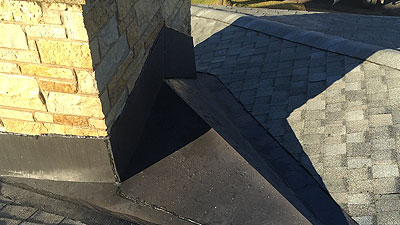
Large Cricket Flashing
Your chimney may need repairs if:
- You notice discoloration in the attic wood framing or the drywall near the chimney. Snow, ice, or high winds could have damaged the flashing.
- You notice a drip soon after it starts raining.
- The walls near the chimney are damp, the paint is peeling, or the drywall is flaking.
- The wood framing around the chimney is saturated, and water drips hours after it stops raining.
Having a professional regularly inspect and maintain your chimney flashing ensures it is in good condition and functions properly. If your chimney flashing is damaged or in poor condition, it is essential to repair or replace it to protect your home from internal moisture and chimney fires.
Chimney Flashing
Where is the flashing located?
Chimney flashing is located where your roof and chimney meet. Chimney flashings are one of the most common places a chimney will leak. If you’ve noticed leaking in your attic or around your chimney, the flashing likely needs repair.
What is Chimney Flashing?
The flashing needs to be watertight to prevent water or moisture from causing damage to the interior of the house. Flashing involves a series of steps. These steps need to be done in the correct order to prevent any damage and costly repairs. Carlson’s Chimney uses galvanized steel flashing and not aluminum. Aluminum corrodes over time when it comes in contact with the lime in the masonry.
The flashing repair process has three major parts: the underlayment, step flashing (tin singles), and the counter flashing. When replacing the flashing, we install an ice and water barrier underlayment to the wood deck. The ice and water barrier seals the nails as we install the shingles around the chimney. We install tin shingles in sequence with the asphalt shingles so that water doesn’t enter where the shingles meet the brick/stone. The counter flashing is a piece of metal with a ½” bend at the top that is cut into the masonry above the tin shingles. This flashing also stops the water from entering at the top of the chimney. The pieces are then screwed or riveted together. The metal overlaps, so only a single bead of caulk seals the seams.

Copper Flashing

Cricket Flashing

Large Cricket Flashing
Your chimney may need repairs if:
- You notice discoloration in the attic wood framing or the drywall near the chimney. Snow, ice, or high winds could have damaged the flashing.
- You notice a drip soon after it starts raining.
- The walls near the chimney are damp, the paint is peeling, or the drywall is flaking.
- The wood framing around the chimney is saturated, and water drips hours after it stops raining.
Flashing Install
Large Cricket Flashing Install
Having a professional regularly inspect and maintain your chimney flashing ensures it is in good condition and functions properly. If your chimney flashing is damaged or in poor condition, it is essential to repair or replace it to protect your home from internal moisture and chimney fires.

